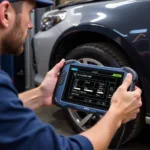OBD2 SRS scanners are essential tools for diagnosing and repairing airbag systems in modern vehicles. Unlike basic OBD2 scanners that read engine codes, SRS scanners specifically target the Supplemental Restraint System (SRS), which includes airbags, seatbelt tensioners, and impact sensors.
This comprehensive guide explores the intricacies of OBD2 SRS scanners, providing valuable insights into their functionalities, benefits, and how they empower car owners and mechanics to ensure optimal safety and vehicle performance.
What is an OBD2 SRS Scanner?
An OBD2 SRS scanner, also known as an airbag scanner, is a specialized diagnostic tool designed to communicate with a vehicle’s SRS control module. This module constantly monitors the various components of the airbag system, and in the event of a malfunction, it stores a specific trouble code in its memory.
By connecting an OBD2 SRS scanner to the vehicle’s OBD2 port, users can read and interpret these trouble codes, enabling them to identify the root cause of airbag system issues. This information is crucial for efficient troubleshooting and repair, ensuring the airbag system functions as intended in case of an accident.
Why Do You Need an OBD2 SRS Scanner?
Having an OBD2 SRS scanner at your disposal offers several key advantages:
- Accurate Airbag Diagnosis: An SRS scanner provides precise identification of airbag system faults, eliminating guesswork and potentially costly trial-and-error repairs.
- Enhanced Safety: By allowing for timely detection and repair of airbag problems, SRS scanners contribute to a safer driving experience by ensuring the system’s readiness in critical situations.
- Cost Savings: Identifying issues early on with an SRS scanner can prevent minor problems from escalating into major (and expensive) repairs down the line.
- DIY Repairs: For the mechanically inclined, an OBD2 SRS scanner empowers car owners to diagnose and address airbag-related issues themselves, saving on professional labor costs.
How to Use an OBD2 SRS Scanner
Using an OBD2 SRS scanner is generally a straightforward process:
- Locate the OBD2 Port: This port is typically found under the dashboard on the driver’s side.
- Connect the Scanner: Plug the SRS scanner into the OBD2 port.
- Turn on the Ignition: Turn the key to the “on” position but do not start the engine.
- Access SRS System: Navigate to the SRS or Airbag section on the scanner’s menu.
- Read and Interpret Codes: The scanner will display any stored SRS trouble codes. Consult the vehicle’s service manual or a reliable online database to decipher the codes and understand their meanings.
- Clear Codes: After addressing the underlying issue, use the scanner to clear the codes from the SRS module’s memory.
Types of OBD2 SRS Scanners
There are various types of OBD2 SRS scanners available, catering to different needs and budgets:
- Basic SRS Scanners: These affordable scanners can read and clear basic SRS trouble codes, making them suitable for DIY enthusiasts and car owners.
- Advanced SRS Scanners: Offering more features and capabilities, advanced scanners can access live data streams, perform bi-directional tests (actuating components), and provide detailed diagnostic reports. These are ideal for professional mechanics and workshops.
Choosing the Right OBD2 SRS Scanner
Selecting the appropriate OBD2 SRS scanner depends on individual requirements:
- Vehicle Compatibility: Ensure the scanner supports the specific make, model, and year of your vehicle.
- Features: Consider the desired functionalities, such as live data, bi-directional tests, and code definitions.
- Budget: Determine a realistic budget, keeping in mind that advanced features often come at a higher price point.
- User Friendliness: Opt for a scanner with an intuitive interface and clear instructions for ease of use.
Conclusion
OBD2 SRS scanners are invaluable tools for maintaining the safety and reliability of a vehicle’s airbag system. By enabling accurate diagnosis and timely repair of SRS issues, these scanners play a crucial role in ensuring the effectiveness of this critical safety feature.
When choosing an OBD2 SRS scanner, consider your specific needs and budget to make an informed decision. By investing in the right scanner, you gain peace of mind knowing that you have the means to address airbag-related concerns effectively.
